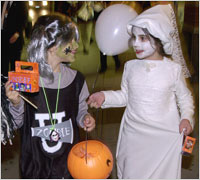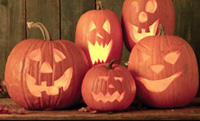|
|
|
 |
|
|
American Holidays > Halloween |
|
Halloween, the last day of October, has a special significance for children, who dress in funny or ghostly costumes and knock on neighborhood doors shouting "Trick or Treat!" Pirates and princesses, ghosts and witches all hold bags open to catch the candy or other goodies that the neighbors drop in. Since
the 800's November 1st is a religious holiday known as All Saints' Day.
The Mass that was said on this day was called Allhallowmas. The evening
before became known as All Hallow e'en, or Halloween. Like some other
American celebrations, its origins lie in both pre-Christian and Christian
customs. Symbols of Halloween Halloween originated as a celebration connected with evil spirits. Witches flying on broomsticks with black cats, ghosts, goblins and skeletons have all evolved as symbols of Halloween. They are popular trick-or-treat costumes and decorations for greeting cards and windows. Black is one of the traditional Halloween colors, probably because Halloween festivals and traditions took place at night. In the weeks before October 31, Americans decorate windows of houses and schools with silhouettes of witches and black cats.
Pumpkins are also a symbol of Halloween. The pumpkin is an orange-colored squash, and orange has become the other traditional Halloween color. Carving pumpkins into jack-o'-lanterns is a Halloween custom also dating back to Ireland. A legend grew up about a man named Jack who was so stingy that he was not allowed into heaven when he died, because he was a miser. He couldn't enter hell either because he had played jokes on the devil. As a result, Jack had to walk the earth with his lantern until Judgment Day. The Irish people carved scary faces out of turnips, beets or potatoes representing "Jack of the Lantern," or jack-o'-lantern. When the Irish brought their customs to the United States, they carved faces on pumpkins because in the autumn they were more plentiful than turnips. Today jack-o'-lanterns in the windows of a house on Halloween night let costumed children know that there are goodies waiting if they knock and say "Trick or Treat!" |
|||||
| Feature Article: | |||||
| U.S.
Children, Adults Celebrate Halloween. By Michael Jay
Friedman While not an official holiday, the traditional October 31 Halloween celebration is much beloved by children in the United States, for whom the day is a chance to don costumes'often depicting ghosts, goblins and other "supernatural" creatures'and to collect candy and other treats from adults. Most Americans consider Halloween a festive occasion, but its roots long predate the United States and its meaning has changed greatly over time. Even today, many other nations observe their own versions of this long-observed festival. (America.gov, October 30, 2008.) |
|||||
| Texts
are abridged from U.S. State Department IIP
publications and other U.S. government materials. |
|||||
DISCLAIMER
Any reference obtained from this server to a specific commercial product, process, or service does not constitute or imply an endorsement by the United States Government of the product, process, or service, or its producer or provider. The views and opinions expressed in any referenced document do not necessarily state or reflect those of the United States Government. |
 U.S. Diplomatic Mission to Germany /Public Affairs/ Information Resource Centers Updated: September 2010 |

